Eyes on Target! Absolute #6

Originally published in 2011
Why it’s important to keep your eyes on the prize
Keep your eye on the ball!” is a popular bit of wisdom heard often in golf and baseball, but it also has expanded to many other sports. How often, for example, have you seen a football player fail to catch a kickoff because he took his eyes off the ball for a split second to determine where he was going to run? Although keeping your eye on the ball is not one of the Six Absolutes, there is one that is very similar and just as important: Eyes on Target.
Living in the Information Age, coaches are often bombarded with elaborate details about sports biomechanics. During a power clean an athlete can often keep the barbell closer to their body by turning their wrists slightly under, which positions their elbows out to the side. Such details are all valuable, and often small details can make the difference between winning and losing; however, before getting to that level of technical precision, coaches need to focus on the basics.
Eyes on Target refers to the importance of focusing your eyes on your immediate goal. Using the example of the football player receiving a kickoff return, he needs to focus on the target, in this case the football, so that he can securely make the catch. After securing the ball, the player has a new target, which is the most appropriate path to take to avoid getting tackled. Likewise, for the opposing players, the “target” is the ball carrier’s lower body, not the upper body, as that’s not the best way to make a tackle. But there are exceptions.
Let’s say it’s late in a football game and your team is behind. You’re on defense and you must create a turn-over to enable the offense to catch up. Instead of tackling while your eyes are focused on the ball carrier’s lower body, you could try switching to targeting the ball. Yes, making the tackle is important, but the tradeoff is that by swinging at the ball you have a better chance of causing a fumble. Let’s look at a few more examples.
One of the most dangerous errors in football occurs when the head is down during a tackle. Keeping your head up, with your eyes on the target of the area of the body you want to tackle, is the best and safest way to tackle. When your head is down, the spine is straight, and its ability to absorb the shock of impact is compromised. This compression can lead to concussions and spinal cord injuries. Simply keeping the eyes on target can help avoid this dangerous posture.
In baseball, it’s been said that it’s impossible to keep your eye on the ball throughout the entire pitch when it’s thrown at high speeds. That may be true, but the principle is the same. In effect, what researchers at American University and the University of Southern California have discovered is that during a pitch a batter switches from central vision to peripheral vision. This switching explains why fastballs apparently rise and curveballs appear to break.

In the weight room, Eyes on Target is a great teaching tool for coaches. In the squat, often an athlete is taught to look up at the ceiling at the start to help keep their back tight. While this posture may seem comfortable at the start, it’s at the bottom position where things go bad because it is virtually impossible to look at the same point on the ceiling when you’re in the bottom position. As a result, the eyes move to a different target, the head follows and the body moves out of position. Don’t look up and don’t look down; instead, stare intensely straight ahead and fix your eyes on a single point throughout the entire lift.
See videos on all the Six Absolutes HERE
See A Closer Look at Absolute #1 Here - #2 Here - #3 Here - #4 & 5 Here
Eyes on Target is important to proper posture, especially to prevent or correct the condition known as round shoulders. Round shoulders refers to a posture characterized by an exaggerated curvature of the upper portion of the spine and excessive forward positioning of the shoulders (and often the head). Swimmers, wrestlers and gymnasts, and those who spend a lot of time on a computer often display this type of posture. Rounding of the shoulders reduces the flexibility in the shoulder joint and makes the joint more susceptible to shoulder impingement syndromes and dislocations. Keeping the eyes forward on a target in front of you, rather than down, is the first step in helping to prevent and correct round shoulders.
At BFS clinics, athletes learn this absolute so thoroughly that by the end of the day all you have to do is say, “Eyes!” and an immediate perfect correction takes place. Eyes on Target is one of the great coaching secrets that will give you a big edge over your opponents. Use it often.
Save 20% on the BFS 6 Absolute poster set during our June Summer Steals!
And Download the FREE ebook detailing how to coach with the BFS 6 Absolutes

